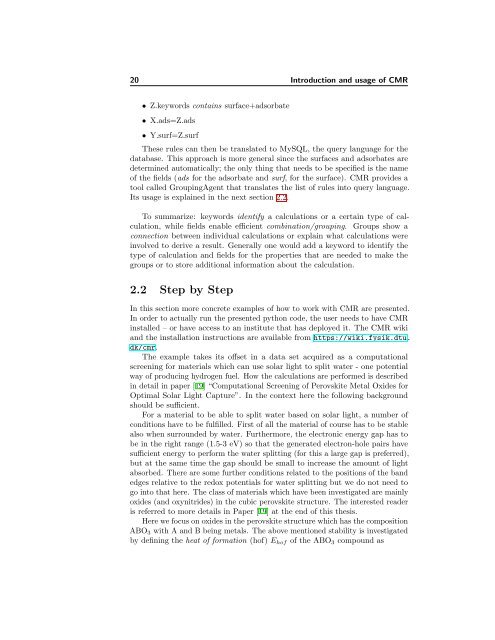The Computational Materials Repository
The Computational Materials Repository
The Computational Materials Repository
- No tags were found...
You also want an ePaper? Increase the reach of your titles
YUMPU automatically turns print PDFs into web optimized ePapers that Google loves.
20 Introduction and usage of CMR• Z.keywords contains surface+adsorbate• X.ads=Z.ads• Y.surf=Z.surf<strong>The</strong>se rules can then be translated to MySQL, the query language for thedatabase. This approach is more general since the surfaces and adsorbates aredetermined automatically; the only thing that needs to be specified is the nameof the fields (ads for the adsorbate and surf, for the surface). CMR provides atool called GroupingAgent that translates the list of rules into query language.Its usage is explained in the next section 2.2.To summarize: keywords identify a calculations or a certain type of calculation,while fields enable efficient combination/grouping. Groups show aconnection between individual calculations or explain what calculations wereinvolved to derive a result. Generally one would add a keyword to identify thetype of calculation and fields for the properties that are needed to make thegroups or to store additional information about the calculation.2.2 Step by StepIn this section more concrete examples of how to work with CMR are presented.In order to actually run the presented python code, the user needs to have CMRinstalled – or have access to an institute that has deployed it. <strong>The</strong> CMR wikiand the installation instructions are available from https://wiki.fysik.dtu.dk/cmr.<strong>The</strong> example takes its offset in a data set acquired as a computationalscreening for materials which can use solar light to split water - one potentialway of producing hydrogen fuel. How the calculations are performed is describedin detail in paper [19] “<strong>Computational</strong> Screening of Perovskite Metal Oxides forOptimal Solar Light Capture”. In the context here the following backgroundshould be sufficient.For a material to be able to split water based on solar light, a number ofconditions have to be fulfilled. First of all the material of course has to be stablealso when surrounded by water. Furthermore, the electronic energy gap has tobe in the right range (1.5-3 eV) so that the generated electron-hole pairs havesufficient energy to perform the water splitting (for this a large gap is preferred),but at the same time the gap should be small to increase the amount of lightabsorbed. <strong>The</strong>re are some further conditions related to the positions of the bandedges relative to the redox potentials for water splitting but we do not need togo into that here. <strong>The</strong> class of materials which have been investigated are mainlyoxides (and oxynitrides) in the cubic perovskite structure. <strong>The</strong> interested readeris referred to more details in Paper [19] at the end of this thesis.Here we focus on oxides in the perovskite structure which has the compositionABO 3 with A and B being metals. <strong>The</strong> above mentioned stability is investigatedby defining the heat of formation (hof) E hof of the ABO 3 compound as












